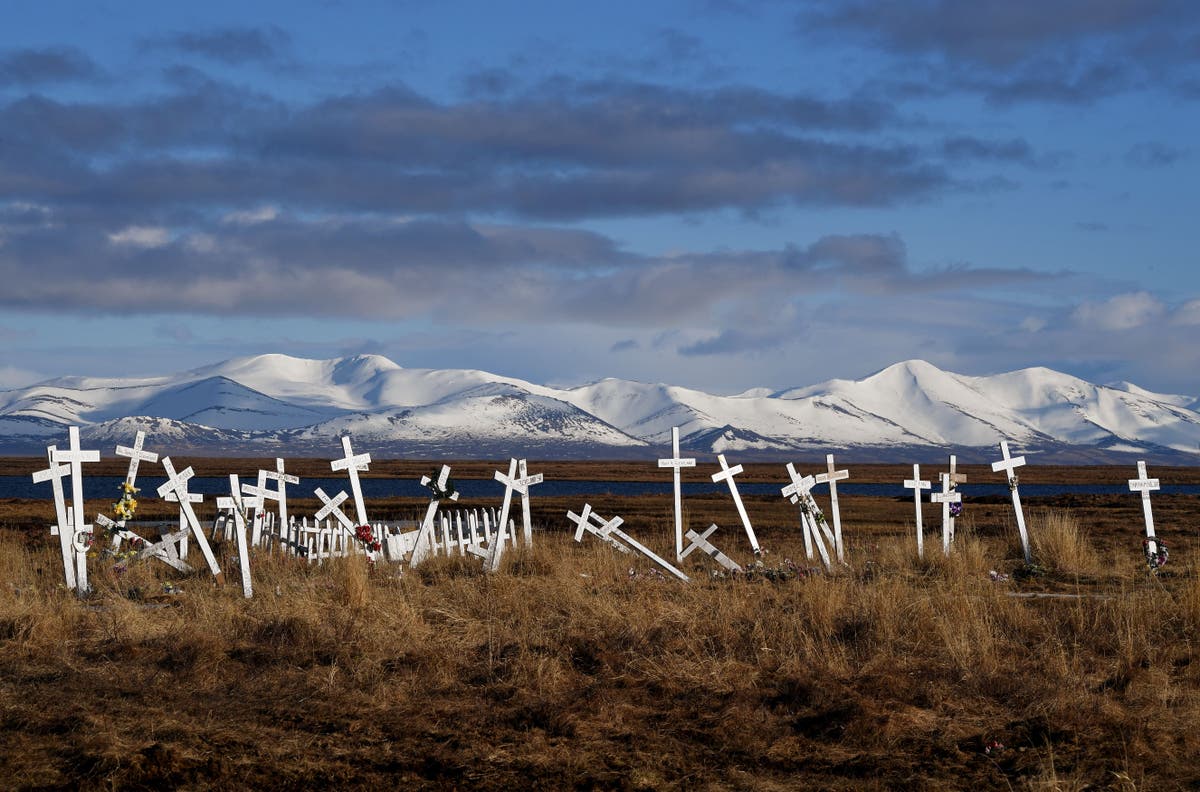Ancient “zombie viruses” frozen in melting Arctic permafrost could fuel a new pandemic if unleashed by climate change, scientists have warned.
Global heating is enabling increased human activity in the Earth’s northernmost reaches, as melting sea ice opens up shipping and industrial possibilities, including mining deep into the permafrost which covers a fifth of the northern hemisphere, mainly in Canada, Siberia and Alaska.
Fearing the possibility of awakening a disease from humanity’s long-forgotten past, scientists have reportedly started to plan an Arctic monitoring network in the hopes of keeping a watchful eye for any early cases of a disease sparked by these ancient viruses, also known as Methusela microbes.
A cemetery sits on melting permafrost tundra at the Yupik Eskimo village of Quinhagak in Alaska
(Mark Ralston/AFP via Getty Images)
Ancient viruses have already been found in Siberian permafrost, including one sample which was 48,500 years old. A team led by geneticist Jean-Michel Claverie have revived several such viruses, capable of infecting only single-cell organisms.
But the scientist fear viruses capable of infecting humans likely also lurk in the permafrost. “We see the traces of many, many, many other viruses,” Professor Claverie told CNN in March, adding: “If the amoeba viruses are still alive, there is no reason why the other viruses will not be still alive, and capable of infecting their own hosts.”
As a result, Prof Claverie is among scientists working with the University of the Arctic network on plans to establish quarantine facilities and provide medical expertise that could pinpoint and attempt to treat any early cases without them leaving the region, according to The Observer.
“At the moment, analyses of pandemic threats focus on diseases that might emerge in southern regions and then spread north,” said Prof Claverie, of Aix-Marseille University, told the paper. “By contrast, little attention has been given to an outbreak that might emerge in the far north and then travel south – and that is an oversight, I believe.
“There are viruses up there that have the potential to infect humans and start a new disease outbreak.” Among the genomic traces of human pathogens identified already by the team in Siberian permafrost are poxviruses and herpesviruses, he said.
According to scientists, Alaska has been warming twice as fast as the global average
(Mark Ralston/AFP via Getty Images)
Virologist Marion Koopmans agreed, telling the paper: “We don’t know what viruses are lying out there in the permafrost but I think there is a real risk that there might be one capable of triggering a disease outbreak – say of an ancient form of polio. We have to assume that something like this could happen.”
With forecasts suggesting the Arctic Sea will be ice-free as early as 2040 due to climate breakdown, it is the prospect of increased human activity in the Arctic, as opposed to melting thermafrost, which most concerns Prof Claverie.
“Huge mining operations are being planned, and are going to drive vast holes into the deep permafrost to extract oil and ores,” he said. “Those operations will release vast amounts of pathogens that still thrive there. Miners will walk in and breath the viruses. The effects could be calamitous.”
“Our immune systems may have never been in contact with some of those microbes, and that is another worry,” said Prof Claverie. “The scenario of an unknown virus once infecting a Neanderthal coming back at us, although unlikely, has become a real possibility.”
Prof Koopmans added: “If you look at the history of epidemic outbreaks, one of the key drivers has been change in land use. Nipah virus was spread by fruit bats who were driven from their habitats by humans. Similarly, monkeypox has been linked to the spread of urbanisation in Africa.
“And that is what we are about to witness in the Arctic: a complete change in land use, and that could be dangerous, as we have seen elsewhere.”

Sarah Carter is a health and wellness expert residing in the UK. With a background in healthcare, she offers evidence-based advice on fitness, nutrition, and mental well-being, promoting healthier living for readers.








